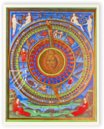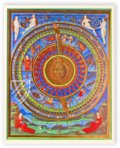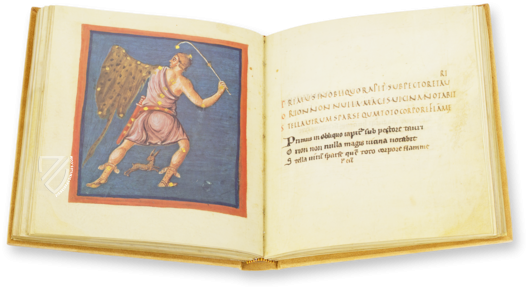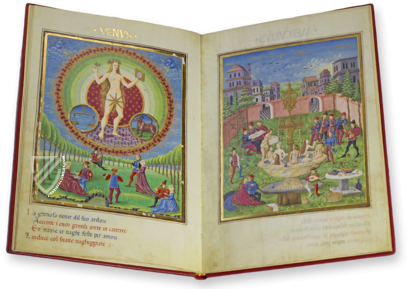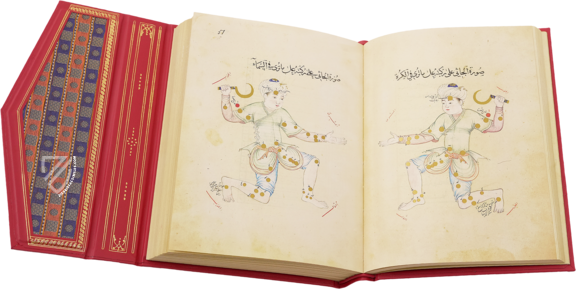On the Stars
(under 1,000€)
The ancients’ knowledge of astronomy was mostly lost in the West after the Fall of Rome, but this spurred great interest in studying the stars. Although long outclassed by their counterparts in the Islamic World, medieval Europeans made important contributions to astronomy. Astronomical models depicting planetary orbits in a series of concentric circles have their root in antiquity but became common in the Middle Ages. By the Late Middle Ages, it was typical for all seven planets to be depicted, plus four more circles under the moon for fire, air, water, and earth. All of these were surrounded by a sphere of fixed stars held up by the angels. Astronomy manuscripts are counted among the finest examples of medieval miniature painting, they represent the splendid fusion of art and science.
On the Stars
Western astronomy stagnated after the Fall of Rome and began to revive during the Scholastic Renaissance of the 12th century. Nonetheless, the work was continued by people like Saint Isidore of Seville (c. 560–636), who attempted to reconcile the knowledge of ancient philosophers and scholars with that of the Church Fathers. Medieval astronomers sought to establish a symbiotic relationship between the principles of Ptolemy’s astronomy and those of Aristotle’s physics, and to reconcile the differences between them. Scholars from the Arab world were particularly distinguished as astronomers. European astronomers benefited enormously from their erudition.
Depicting the theories and findings of the great stargazers of history was the task of illuminators who created a genre of medieval manuscripts that boasts some of the most skillful and complex miniature painting to survive from the period. European treatises on the stars began to proliferate in the 15th century and took advantage of the more sophisticated techniques employed by Renaissance artists to represent the content of the texts being produced by astronomers at the time. Some of these works even sought to elucidate a connection between astronomy/astrology and health/medicine.
These ten pages offer an overview of splendidly illuminated medieval astronomical manuscripts:
Ursa Major and Ursa Minor
Aratea, Leiden University Library
Frankish Empire, 9th centuryAn Angel
Cosmography of Al-Kaswini, Staatsbibliothek, Munich
Iraq, 1280Two Astronomers
Astronomical Manuscript of King Wenceslaus IV, Österreichische Nationalbilbiothek, Vienna
Prague, 1392–93Alfonsine Star Tables
Astronomical Manuscript of King Wenceslaus IV, Österreichische Nationalbilbiothek, Vienna
Prague, 1392–93January with the Zodiac Signs Capricorn and Aquarius
Tres riches heures de Duc de Berry, Musee Conde, Chantilly
Paris, ca. 1413June with the Zodiac Sign Cancer
Bedford Hours, The British Library, London
London, ca. 1420Venus
De Sphaera, Biblioteca Estense Universitaria, Modena
Upper Italy, ca. 1450–1470The Sun
Natur des Weltalls, Herzog August Bibliothek, Wolfenbüttel
Utrecht, 1465–1470Sundial with Zodiac Signs
Astrolabium Planum of Heidelberg, Heidelberg University Library
Regensburg, ca. 1491The Anatomical Zodiac Man
Golden Calendar of Albert Glockendon from 1526, Staatsbibliothek, Berlin
Nuremberg, 1526
Codicology
- Alternative Titles
- Kassette Von den Gestirnen
Meisterwerke zur mittelalterlichen Sternenwelt - Origin
- France
- Date
- 9th–16th century
- Illustrations
- 10 miniatures
- Content
- Ten leaves from important manuscripts
Astrolabium Planum of Heidelberg
Astroloabe with Zodiac Signs
A central disc revolves around a stylized sun with an inscribed moon: in the inner ring, the moon phases are marked with Arabic numerals and shown schematically next to them, in the outer ring, the Zodiac signs are artfully depicted with an inscribed constellation. The twelve hours are marked on the outer ring with Roman numerals. Berthold Furtmeyr’s wonderful color palette makes the image burst from the page and the sun in the middle casts an almost hypnotic gaze on the beholder.

Astronomical Manuscript of King Wenceslas IV
The Alfonsine Tables
Used for the calculation of the Sun, Moon, and planets relative to the fixed stars, the so-called Alfonsine Tables were one of the greatest intellectual accomplishments of 13th century Europe. They are named after the man who patronized their creation, King Alfonso X of Castile, a monarch so learned he has both the epithets of The Wise and The Astrologer.
King Alfonso is depicted as a late–14th century monarch in the historiated initial, but this might be simultaneously intended to represent King Wenceslas IV of Bohemia, who commissioned this work, thus associating the two Kings with one another. Wenceslaus was a very educated man and some of the most magnificent illuminated manuscripts of the Gothic period were created at his behest.

#1 Kassette Von den Gestirnen
Language: German
(under 1,000€)
- Treatises / Secular Books
- Apocalypses / Beatus
- Astronomy / Astrology
- Bestiaries
- Bibles / Gospels
- Chronicles / History / Law
- Geography / Maps
- Saints' Lives
- Islam / Oriental
- Judaism / Hebrew
- Single Leaf Collections
- Leonardo da Vinci
- Literature / Poetry
- Liturgical Manuscripts
- Medicine / Botany / Alchemy
- Music
- Mythology / Prophecies
- Psalters
- Other Religious Books
- Games / Hunting
- Private Devotion Books
- Other Genres
- Afghanistan
- Armenia
- Austria
- Belgium
- Belize
- Bosnia and Herzegovina
- China
- Colombia
- Costa Rica
- Croatia
- Cyprus
- Czech Republic
- Denmark
- Egypt
- El Salvador
- Ethiopia
- France
- Germany
- Greece
- Guatemala
- Honduras
- Hungary
- India
- Iran
- Iraq
- Israel
- Italy
- Japan
- Jordan
- Kazakhstan
- Kyrgyzstan
- Lebanon
- Liechtenstein
- Luxembourg
- Mexico
- Morocco
- Netherlands
- Palestine
- Panama
- Peru
- Poland
- Portugal
- Romania
- Russia
- Serbia
- Spain
- Sri Lanka
- Sweden
- Switzerland
- Syria
- Tajikistan
- Turkey
- Turkmenistan
- Ukraine
- United Kingdom
- United States
- Uzbekistan
- Vatican City
- A. Oosthoek, van Holkema & Warendorf
- Aboca Museum
- Ajuntament de Valencia
- Akademie Verlag
- Akademische Druck- u. Verlagsanstalt (ADEVA)
- Aldo Ausilio Editore - Bottega d’Erasmo
- Alecto Historical Editions
- Alkuin Verlag
- Almqvist & Wiksell
- Amilcare Pizzi
- Andreas & Andreas Verlagsbuchhandlung
- Archa 90
- Archiv Verlag
- Archivi Edizioni
- Arnold Verlag
- ARS
- Ars Magna
- ArtCodex
- AyN Ediciones
- Azimuth Editions
- Badenia Verlag
- Bärenreiter-Verlag
- Belser Verlag
- Belser Verlag / WK Wertkontor
- Benziger Verlag
- Bernardinum Wydawnictwo
- BiblioGemma
- Biblioteca Apostolica Vaticana (Vaticanstadt, Vaticanstadt)
- Bibliotheca Palatina Faksimile Verlag
- Bibliotheca Rara
- Boydell & Brewer
- Bramante Edizioni
- Bredius Genootschap
- Brepols Publishers
- British Library
- C. Weckesser
- Caixa Catalunya
- Canesi
- CAPSA, Ars Scriptoria
- Caratzas Brothers, Publishers
- Carus Verlag
- Casamassima Libri
- Centrum Cartographie Verlag GmbH
- Chavane Verlag
- Christian Brandstätter Verlag
- Circulo Cientifico
- Club Bibliófilo Versol
- Club du Livre
- CM Editores
- Collegium Graphicum
- Collezione Apocrifa Da Vinci
- Comissão Nacional para as Comemorações dos Descobrimentos Portugueses
- Coron Verlag
- Corvina
- CTHS
- D. S. Brewer
- Damon
- De Agostini/UTET
- De Nederlandsche Boekhandel
- De Schutter
- Deuschle & Stemmle
- Deutscher Verlag für Kunstwissenschaft
- DIAMM
- Droz
- E. Schreiber Graphische Kunstanstalten
- Ediciones Boreal
- Ediciones Grial
- Ediclube
- Edições Inapa
- Edilan
- Editalia
- Edition Deuschle
- Edition Georg Popp
- Edition Leipzig
- Edition Libri Illustri
- Editiones Reales Sitios S. L.
- Éditions de l'Oiseau Lyre
- Editions Medicina Rara
- Editorial Casariego
- Editorial Mintzoa
- Editrice Antenore
- Editrice Velar
- Edizioni Edison
- Egeria, S.L.
- Eikon Editores
- Electa
- Emery Walker Limited
- Enciclopèdia Catalana
- Eos-Verlag
- Ephesus Publishing
- Ernst Battenberg
- Eugrammia Press
- Extraordinary Editions
- Fackelverlag
- Facsimila Art & Edition
- Facsimile Editions Ltd.
- Facsimilia Art & Edition Ebert KG
- Faksimile Verlag
- Feuermann Verlag
- Folger Shakespeare Library
- Franco Cosimo Panini Editore
- Friedrich Wittig Verlag
- Fundación Hullera Vasco-Leonesa
- G. Braziller
- Gabriele Mazzotta Editore
- Gebr. Mann Verlag
- Gesellschaft für graphische Industrie
- Getty Research Institute
- Giovanni Domenico de Rossi
- Giunti Editore
- Graffiti
- Grafica European Center of Fine Arts
- Guido Pressler
- Guillermo Blazquez
- Gustav Kiepenheuer
- H. N. Abrams
- Harrassowitz
- Harvard University Press
- Helikon
- Hendrickson Publishers
- Henning Oppermann
- Herder Verlag
- Hes & De Graaf Publishers
- Hoepli
- Holbein-Verlag
- Houghton Library
- Hugo Schmidt Verlag
- Idion Verlag
- Il Bulino, edizioni d'arte
- ILte
- Imago
- Insel Verlag
- Instituto de Estudios Altoaragoneses
- Instituto Nacional de Antropología e Historia
- Istituto dell'Enciclopedia Italiana - Treccani
- Istituto Ellenico di Studi Bizantini e Postbizantini
- Istituto Geografico De Agostini
- Istituto Poligrafico e Zecca dello Stato
- Italarte Art Establishments
- Jan Thorbecke Verlag
- Johnson Reprint Corporation
- Josef Stocker
- Josef Stocker-Schmid
- Jugoslavija
- Karl W. Hiersemann
- Kasper Straube
- Kaydeda Ediciones
- Kindler Verlag / Coron Verlag
- Kodansha International Ltd.
- Konrad Kölbl Verlag
- Kurt Wolff Verlag
- La Liberia dello Stato
- La Linea Editrice
- La Meta Editore
- Lambert Schneider
- Landeskreditbank Baden-Württemberg
- Leo S. Olschki
- Les Incunables
- Liber Artis
- Library of Congress
- Libreria Musicale Italiana
- Lichtdruck
- Lito Immagine Editore
- Lumen Artis
- Lund Humphries
- M. Moleiro Editor
- Maison des Sciences de l'homme et de la société de Poitiers
- Manuscriptum
- Martinus Nijhoff
- Maruzen-Yushodo Co. Ltd.
- MASA
- Massada Publishers
- McGraw-Hill
- Metropolitan Museum of Art
- Militos
- Millennium Liber
- Müller & Schindler
- Nahar - Stavit
- Nahar and Steimatzky
- National Library of Wales
- Neri Pozza
- Nova Charta
- Oceanum Verlag
- Odeon
- Orbis Mediaevalis
- Orbis Pictus
- Österreichische Staatsdruckerei
- Oxford University Press
- Pageant Books
- Parzellers Buchverlag
- Patrimonio Ediciones
- Pattloch Verlag
- PIAF
- Pieper Verlag
- Plon-Nourrit et cie
- Prestel Verlag
- Princeton University Press
- Prisma Verlag
- Priuli & Verlucca, editori
- Pro Sport Verlag
- Propyläen Verlag
- Pytheas Books
- Quaternio Verlag Luzern
- Reales Sitios
- Recht-Verlag
- Reichert Verlag
- Reichsdruckerei
- Reprint Verlag
- Riehn & Reusch
- Roberto Vattori Editore
- Rosenkilde and Bagger
- Roxburghe Club
- Salerno Editrice
- Saltellus Press
- Sandoz
- Sarajevo Svjetlost
- Schöck ArtPrint Kft.
- Schulsinger Brothers
- Scolar Press
- Scrinium
- Scripta Maneant
- Scriptorium
- Shazar
- Siloé, arte y bibliofilia
- SISMEL - Edizioni del Galluzzo
- Sociedad Mexicana de Antropología
- Société des Bibliophiles & Iconophiles de Belgique
- Soncin Publishing
- Sorli Ediciones
- Stainer and Bell
- Studer
- Styria Verlag
- Sumptibus Pragopress
- Szegedi Tudomànyegyetem
- Taberna Libraria
- Tarshish Books
- Taschen
- Tempus Libri
- Testimonio Compañía Editorial
- Thames and Hudson
- The Clear Vue Publishing Partnership Limited
- The Facsimile Codex
- The Folio Society
- The Marquess of Normanby
- The Richard III and Yorkist History Trust
- Tip.Le.Co
- TouchArt
- TREC Publishing House
- TRI Publishing Co.
- Trident Editore
- Typis Regiae Officinae Polygraphicae
- Union Verlag Berlin
- Universidad de Granada
- University of California Press
- University of Chicago Press
- Urs Graf
- Vallecchi
- Van Wijnen
- VCH, Acta Humaniora
- VDI Verlag
- VEB Deutscher Verlag für Musik
- Verlag Anton Pustet / Andreas Verlag
- Verlag Bibliophile Drucke Josef Stocker
- Verlag der Münchner Drucke
- Verlag für Regionalgeschichte
- Verlag Styria
- Vicent Garcia Editores
- W. Turnowski Ltd.
- W. Turnowsky
- Waanders Printers
- Wiener Mechitharisten-Congregation (Wien, Österreich)
- Wissenschaftliche Buchgesellschaft
- Wissenschaftliche Verlagsgesellschaft
- Wydawnictwo Dolnoslaskie
- Xuntanza Editorial
- Zakład Narodowy
- Zollikofer AG




